An Innovative Approach for Subnational Climate Adaptation of Biodiversity and Ecosystems: The Case Study of a Regional Strategy in Italy
Abstract
:1. Introduction
- Hazard: “The potential occurrence of physical events associated with climate or trends or their physical impacts”;
- Exposure: “The presence of people, livelihoods, species and ecosystems, environmental functions, services, and resources, infrastructures, or economic, social, cultural assets in places and contexts that could be negatively affected”;
- Vulnerability: “The propensity to be negatively affected. It encompasses a variety of concepts and elements including sensitivity to harm and a lack of coping and fit capacity”.
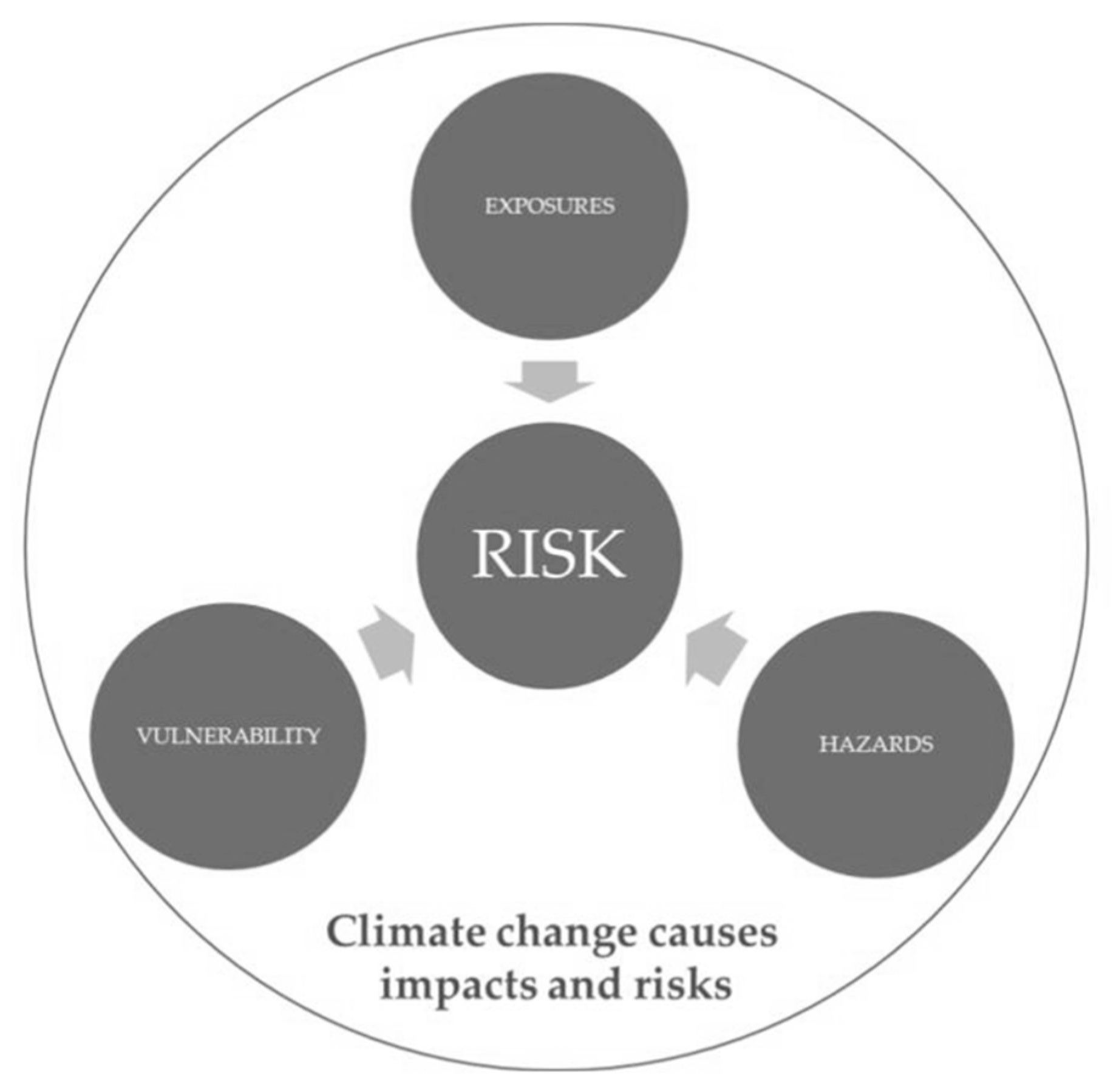
2. Regional Approach for a Sectoral Adaptation to Climate Change Impacts
- Identification and involvement of experts for the sectoral team (1 month);
- First work group: identification of current and future impacts (1 month);
- Second work group: measures elaboration and priority setting (1 month);
- Public return of results (1 month).
3. The Case Study of Regional Strategy on Climate Change of Piedmont
3.1. Phase 1: Identification and Involvement of Experts for the Sectoral Team
3.2. Phase 2: First Work Group: Identification of Current and Future Impacts
3.3. Phase 3: Second Work Group: Measures Elaboration and Priority Setting
3.4. Phase 4: Dissemination
4. Results
4.1. Results of Phase 1: Identification and Involvement of Experts for Sectoral Team
4.2. Results of Phase 2: First Work Group: Identification of Current and Future Impacts
- Changes in physiological processes (PHY);
- Changes in morphology (size, color, etc.) (MOR);
- Behavior changes (reproductive, trophic, etc.) (COM);
- Changes in phenology (PHE);
- Changes in spatial distribution (DIS);
- Changes in communities’ species composition and interactions (COM. INT);
- Changes in population structure and dynamics (STR. DYN);
- Alteration of the provided ecosystem services (ECO. S.);
- Direct impacts from sudden anomalous events, such as fires, droughts and extreme temperatures (DIR. I.);
- Impacts related to climate change maladaptation (MAL).
4.3. Results of Phase 3: Second Work Group: Elaboration of Measures and Definition of Their Priorities
4.4. Results of Phase 4: Dissemination
5. Discussion
5.1. Advanced Expert-Elicitation Approach
5.2. Effective Approach
5.3. Efficient Approach
5.4. Disclosure-Based Approach
5.5. Limitations of the Proposed Approach
6. Conclusions
Author Contributions
Funding
Institutional Review Board Statement
Data Availability Statement
Acknowledgments
Conflicts of Interest
Appendix A
| V | IA | IT | I | H | A | M | |
|---|---|---|---|---|---|---|---|
| Changes in Physiological Processes (PHY) | |||||||
| Changes in photosynthetic activity | ● | ||||||
| Changes in water use and transpiration | ● | ||||||
| Changes in germination biology | ● | ||||||
| Hormonal changes | ● | ● | |||||
| Respiratory process alteration | ● | ● | |||||
| Increase in oxygen consumption rate | ● | ||||||
| Increase in parasitosis vulnerability | ● | ● | ● | ||||
| Decrease in time of embryo development | ● | ||||||
| Delay in gonad maturation | ● | ||||||
| Changes in metamorphosis/incubation time | ● | ||||||
| Impacts on aestivation | ● | ||||||
| Changes in neoteny rate | ● | ||||||
| Changes in thermoregulation | ● | ● | |||||
| Changes in echolocation | ● | ||||||
| Changes in morphology (MOR) | |||||||
| Changes in wood growth | ● | ||||||
| Changes in size (individuals and/or body structures), in body mass of individuals or structures | ● | ● | ● | ● | ● | ● | |
| Changes in pigmentation | ● | ● | |||||
| Behavioral changes (COM) | |||||||
| Changes in trophic behavior | ● | ● | ● | ● | ● | ||
| Changes in reproductive behavior | ● | ● | ● | ||||
| Changes in locomotion, migration or movement ability | ● | ● | ● | ● | ● | ||
| Changes in phenology (PHE) | |||||||
| Increase in growing period length and advance in phenology | ● | ||||||
| Advance of migration date | ● | ● | |||||
| Changes in reproductive timing | ● | ● | ● | ● | |||
| Extension of reproductive period | ● | ● | ● | ||||
| Advance of hibernation, wintering end | ● | ● | ● | ||||
| Advance of metamorphosis, flickering | ● | ● | ● | ||||
| Changes in activity period (e.g., peak, fly) | ● | ● | |||||
| Mismatch between molt and habitat | ● | ● | |||||
| Changes in spatial distribution (DIS) | |||||||
| Upshift towards higher latitudes or elevations | ● | ● | ● | ● | ● | ● | ● |
| Colonization of areas previously occupied by glaciers | ● | ||||||
| Decrease or disappearance of habitat linked to water occurrence | ● | ● | ● | ||||
| Changes in breeding and wintering ranges | ● | ||||||
| Decrease in habitat, microhabitat or ecological corridor availability | ● | ● | ● | ● | ● | ● | |
| Changes in communities’ species composition and interactions (COM. INT) | |||||||
| Community homogenization: increase in generalists and thermophilic species and decrease in specialists | ● | ● | ● | ● | ● | ● | ● |
| Changes in high elevation habitat composition | ● | ||||||
| Changes in the composition of water-linked habitats | ● | ||||||
| Changes in the vertical structure of forest communities | ● | ||||||
| Changes in ecotypes | ● | ||||||
| Laurophyllisation | ● | ||||||
| Selection of broadleaves at the expense of conifers | ● | ||||||
| Decrease in functional diversity | ● | ● | ● | ● | |||
| New interspecific interactions (e.g., between previously segregated species or species found in a diminishing habitat) | ● | ● | ● | ● | ● | ● | |
| Increase in hybridization probability | ● | ● | |||||
| Increase in predation rate | ● | ● | ● | ● | |||
| Mismatch between preys and predators | ● | ||||||
| Mismatch between trophic resource and consumer | ● | ● | ● | ● | ● | ● | |
| Local species extinction | ● | ● | ● | ● | |||
| Increase in exotic species | ● | ● | ● | ● | ● | ● | ● |
| Increase in parasite damages | ● | ● | |||||
| Increase in algae bloom-induced mortality | ● | ||||||
| Changes in population structures and dynamics (STR. DYN) | |||||||
| Increase in population fragmentation and isolation | ● | ● | ● | ||||
| Decrease in reproductive success | ● | ● | ● | ● | ● | ● | |
| Decrease in life expectancy | ● | ● | ● | ||||
| Decrease in population density | ● | ● | |||||
| Decrease in foraging bee numbers | ● | ||||||
| Decrease in litter size | ● | ||||||
| Direct impacts from sudden anomalous events (DIR. I) | |||||||
| Increase in direct impacts (increase in mortality, decrease in reproductive success) caused by more frequent and prolonged droughts | ● | ● | ● | ● | ● | ● | |
| Increase in direct impacts (increase in mortality, decrease in reproductive success) caused by more frequent and more severe floods | ● | ● | ● | ● | ● | ||
| Increase in direct impacts (increase in mortality, decrease in reproductive success) caused by more frequent and extreme high temperatures | ● | ● | ● | ● | ● | ● | ● |
| Increase in direct impacts (increase in mortality, decrease in reproductive success) caused by more frequent and severe fires | ● | ● | ● | ● | |||
| Increase in direct impacts (increase in mortality, decrease in reproductive success) caused by more frequent and intense hailstorms | ● | ● | ● | ||||
| Increase in direct impacts (increase in mortality, decrease in reproductive success) caused by more frequent and violent wind gusts | ● | ● | |||||
| Increase in direct impacts (increase in mortality, decrease in reproductive success) caused by an increase in tropospheric ozone | ● | ||||||
| Alteration of the provided ecosystem services (ECO. S) | |||||||
| Extinction of iconic species | ● | ||||||
| Decrease in contrast function against parasites | ● | ● | ● | ||||
| Changes in the function of organic matter degradation | ● | ||||||
| Changes in water purification function | ● | ||||||
| Decrease in animal resources necessary for fishing practices | ● | ● | |||||
| Changes in pollination function | ● | ● | ● | ||||
| Decrease or absence of plant nectar and pollen | ● | ● | |||||
| Decrease in honey production | ● | ||||||
| Impacts on the productivity of pastoral activity | ● | ||||||
| Changes in erosion regulamentation | ● | ||||||
| Changes in soil composition and formation | ● | ||||||
| Changes in carbon storage | ● | ||||||
| Changes in precipitation regimes | ● | ||||||
| Changes in albedo | ● | ||||||
| Decrease in landscape diversity | ● | ||||||
| Bioprotection and biodeterioration of cultural heritage | ● | ||||||
| Impacts related to climate change maladaptations (MAL) | |||||||
| Changes in water habitats caused by artificial banks and post-flood interventions | ● | ● | ● | ||||
| Changes in water habitats caused by an increase in irrigation network concreting | ● | ● | ● | ||||
| Changes in water habitats and surrounding vegetations caused by energy generation water sampling | ● | ● | ● | ● | |||
| Changes in water habitats and surrounding vegetation caused by agricultural water sampling | ● | ● | ● | ● | |||
| Increase in the impacts caused by changes induced by climate change in crop choices and practices in agriculture | ● | ● | ● | ||||
| Increase in impacts caused by upshifting of skiing activities | ● | ||||||
| Negative second-degree effects of grazing strategies to counteract climate change | ● | ||||||
| Macro-Categories | Categories | Impact to Manage/Reduce | Measures | Priorities for AB | Priorities for PB |
|---|---|---|---|---|---|
| Information | Research, Evaluation, Monitoring, Data, Models | A | Identification and prioritization of populations, species, and target habitats | ||
| A | Implementation of regionally coordinated monitoring of target populations, species, and habitats based on precise and shared guidelines | ||||
| A | Realization of an atlas of target populations, species and habitats, reporting data and monitoring results | ||||
| A | Integration of climate projections and area predicting models | ||||
| A | Implementation of laboratory research on the impacts of climate change on biodiversity, with a focus on target species | ||||
| A | Implement research on ES and economic evaluation | ||||
| COM_INA | Maintenance and strengthening of germplasm banks | ||||
| PHE, DIS, COM_INA | Investing in an improved pollen network | ||||
| COM_INA | Implement data on wind crashes | ||||
| COM_INA | Mapping of alien species’ ranges | ||||
| COM_INA | Define and set up reporting and alert modes | ||||
| A | Identify target species/habitat monitoring areas | ||||
| PHY, MOR | Implement the preparation of reference samples | ||||
| A | Define impact mechanisms and thresholds | ||||
| A | Implementing Management Guidelines for Vulnerable Species/Habitat Populations | ||||
| A | Development of future scenarios to predict the effectiveness of the applied measures | ||||
| Disclosure, perception, awareness, and education | A | Professional training and dissemination of good practices, involving both local administrators and land managers; for example improved communication and collaboration with farmers, sector technicians and beneficiaries of Rural Development Program funds | |||
| A | Implement the dissemination and involvement of citizens (information campaigns, citizen science, school education) | ||||
| A | Sensitize the users of the territory for recreational activities | ||||
| Governance | Adjustments of regulations, plans, programs, and strategies | A | Expand suitable areas for the conservation of priority species and habitats: expansion of regional and national protected areas, the Natura 2000 network, and the regional ecological network. | ||
| COM_IN | Reinforcement of regulations for the management of alien species | ||||
| A | Increased regulation and control of impacting recreational activities and prohibition of hunting of vulnerable species | ||||
| A | Integrate the theme of fighting the impacts of climate change in the Guidelines for the drafting of Natura 2000 Network Management Plans, Action Plans and wildlife management, etc. | ||||
| COM_IN | Realization of an Emergency Plan with steering committee to manage pathogens | ||||
| A | Implement the Water Protection Plan—2018 revision | ||||
| A | Update the Regional Forest Plan | ||||
| A | Update the Civil Protection Plans | ||||
| A | Update the List of plant species under Absolute Protection | ||||
| COM_IN, STR_DYN, ECO. S | Increased regulation of halieutic inputs | ||||
| DIS | Design of new extensions for wildlife-friendly winter sports facilities | ||||
| A | Enter by law the calculation of CO2 emissions during construction stage | ||||
| Economic and financial tools | A | Improving the management and implementation of climate change-related RDP funds | |||
| A | Directing compensation for adaptation measures | ||||
| ECO. S | Application of payments for SE under L. 221/2015 | ||||
| MAL | Reduction of incentives for new impacting facilities | ||||
| A | Set up implementation of LIFE funding on climate and biodiversity, by private foundations, by PNRR projects | ||||
| Path | A | Promote a suitable pastoral management | |||
| A | Promote a suitable forest management | ||||
| A | Promote a suitable agricultural management | ||||
| COM_INT | Promote the usage of local hayseed | ||||
| A | Natura 2000 network management, effectively applying conservation measures | ||||
| A | Ensure better management of the amount of water intake:
| ||||
| COM_INT | Counteract the increase in pathogen damage | ||||
| COM_INT | Encourage the reduction in ozone precursors | ||||
| A | Encourage to stop/reduce land usage | ||||
| A | Prioritization of specific conservation actions | ||||
| A | Increase multifunctionality and multidisciplinarity | ||||
| A | Ensure increased water quality | ||||
| A | Make riverbed interventions compliant with wildlife’s needs | ||||
| A | Ensure longitudinal ecological continuity along watercourses | ||||
| A | Promote a more suitable public green management | ||||
| A | Implement and support good practices in beekeeping | ||||
| COM_INT | Develop a strategy to limit the negative impacts of alien species | ||||
| Organizational and participatory processes | Partnership and participation | A | Promote interregional coordination | ||
| A | Improve coordination/collaboration between biodiversity protection related areas | ||||
| Institutions | A | Establish an intervention group for the eradication of alien species | |||
| Organization and management | A | Establish a permanent working group on “Climate change and biodiversity” | |||
| Adaptation and improvementof plants and infrastructures | Machinery, materials, and technologies | COM_INT | Encourage the realization of fish ladders and check those already in place | ||
| A | Encourage a new net of passages/crossings | ||||
| Nature-based solutions | Integrated solutions | A | Promote restoration, creation and protection of wetlands | ||
| A | Implement assisted translocation | ||||
| Forest, agro-forest and river ecosystems | A | Promote restoration and protection of bank’s wooded areas | |||
| DIR. I | Encourage fire prevention with prescribed fire, fender strips, etc. | ||||
| A | Implement green urban infrastructure | ||||
| A | Encourage forestry and sustainable arboriculture | ||||
| A | Encourage naturalistic engineering | ||||
| A | Increase planting of native trees, shrubs, and herbaceous plants | ||||
| A | Promote the redevelopment of secondary areas of the watercourse |
References
- Masson-Delmotte, V.; Zhai, P.; Pirani, A.; Connors, S.L.; Péan, C.; Berger, S.; Caud, N.; Chen, Y.; Goldfarb, L.; Gomis, M.I.; et al. (Eds.) IPCC Summary for Policymakers. In Climate Change 2021: The Physical Science Basis. Contribution of Working Group I to the Sixth Assessment Report of the Intergovernmental Panel on Climate Change; IPCC: Geneva, Switzerland, 2021; in press. [Google Scholar]
- MATTM. Strategia Nazionale di Adattamento ai Cambiamenti Climatici; MATTM: Rome, Italy, 2015; 195p. [Google Scholar]
- UN Paris Agreement to the United Nations Framework Convention on Climate Change, Paris, France, 12 December 2015. Available online: https://unfccc.int/sites/default/files/english_paris_agreement.pdf (accessed on 28 March 2022).
- MATTM. Piano Nazionale di Adattamento ai Cambiamenti Climatici; MATTM: Rome, Italy, 2018; submitted. [Google Scholar]
- Siskos, A.P.; Voloudakis, D.; Lalas, D.; Gakis, N.; Andronikos, G.; Gkoutis, D.; Strataki, M. Developing a Regional Climate Change Adaptation Plan for Island Regions. The case of the South Aegean Region in Greece. In Proceedings of the 2nd International Conference ADAPT to CLIMATE, Heraklion, Greece, 24–25 June 2019. [Google Scholar]
- European Commission. Communication from the Commission to the European Parliament, the Council, the European Economic and Social Committee and the Committee of the Regions. Forging a climate-resilient Europe-the New EU Strategy on Adaptation to Climate Change; European Commission: Brussels, Belgium, 2021; 22p. [Google Scholar]
- IPCC. Summary for Policymakers. In Global Warming of 1.5 °C. An IPCC Special Report on the Impacts of Global Warming of 1.5 °C above Pre-Industrial Levels and Related Global Greenhouse Gas Emission Pathways, in the Context of Strengthening the Global Response to the Threat of Climate Change, Sustainable Development, and Efforts to Eradicate Poverty; Masson-Delmotte, V., Zhai, P., Pörtner, H.-O., Roberts, D., Skea, J., Shukla, P.R., Pirani, A., Moufouma-Okia, W., Péan, C., Pidcock, R., et al., Eds.; World Meteorological Organization: Geneva, Switzerland, 2018; 32p. [Google Scholar]
- Tonmoy, F.N.; Cooke, S.M.; Armstrong, F.; Rissik, D. From science to policy: Development of a climate change adaptation plan for the health and wellbeing sector in Queensland, Australia. Environ. Sci. Policy 2020, 108, 1–13. [Google Scholar] [CrossRef]
- European Parliament; Council of the European Union. Regulation (EU) 2021/1119 of the European Parliament and of the Council of 30 June 2021 establishing the framework for achieving climate neutrality and amending Regulations (EC) No 401/2009 and (EU) 2018/1999 (‘European Climate Law’). Off. J. Eur. Union 2021, L 243, 1–17. [Google Scholar]
- European Commission. Communication from the Commission to the European Parliament, the Council, the European Economic and Social Committee and the Committee of the Regions. ‘Fit for 55’: Delivering the EU’s 2030 Climate Target on the Way to Climate Neutrality; European Commission: Brussels, Belgium, 2021; 14p. [Google Scholar]
- European Commission. Study of Adaptation Activities at Regional Level in the EU: Final Study; European Commission: Luxembourg, 2013; 80p. [Google Scholar]
- Aguiar, F.C.; Bentz, J.; Silva, J.M.N.; Fonseca, A.L.; Swart, R.; Duarte Santos, F.; Penha-Lopes, G. Adaptation to climate change at local level in Europe: An overview. Environ. Sci. Policy 2018, 86, 38–63. [Google Scholar] [CrossRef]
- Corfee-Morlot, J.; Kamal-Chaoui, L.; Donovan, M.G.; Cochran, I.; Robert, A.; Teasdale, P.J. Cities, Climate Change and Multilevel Governance; OECD Publishing: Paris, France, 2009; 123p. [Google Scholar]
- Smit, B.; Wandel, J. Adaptation, adaptive capacity and vulnerability. Glob. Environ. Chang. 2006, 16, 282–292. [Google Scholar] [CrossRef]
- IPCC. Climate Change 2014: Impacts, Adaptation, and Vulnerability. Part A: Global and Sectoral Aspects. Contribution of Working Group II to the Fifth Assessment Report of the Intergovernmental Panel on Climate Change; Cambridge University Press: Cambridge, UK; New York, NY, USA, 2014; 1132p. [Google Scholar]
- Mach, K.J.; Planton, S.; von Stechow, C. Annex II: Glossary. In Climate Change 2014: Synthesis Report. Contribution of Working Groups I, II and III to the Fifth Assessment Report of the Intergovernmental Panel on Climate Change; Core Writing Team, Pachauri, R.K., Meyer, L.A., Eds.; IPCC: Geneva, Switzerland, 2014; pp. 117–130. [Google Scholar]
- European Union. Statistical Regions in the European Union and Partner Countries: NUTS and Statistical Regions 2021, 2020th ed.; European Union: Luxembourg, 2020; 196p. [Google Scholar]
- Gray, S. Local Authority Adaptation Strategy Development Guideline (2012-CCRP-FS-14); Environmental Protection Agency; Johnstown Castle, Co.: Wexford, Ireland, 2016; 34p. [Google Scholar]
- Zebisch, M.; Vaccaro, R.; Niedrist, G.; Schneiderbauer, S.; Streifeneder, T.; Weiß, M.; Troi, A.; Renner, K.; Pedoth, L.; Baumgartner, B.; et al. Rapporto sul Clima–Alto Adige; Eurac Research: Bolzano, Italy, 2018; 128p. [Google Scholar]
- Regione Emilia-Romagna. Strategia di Mitigazione e Adattamento per i Cambiamenti Climatici Della Regione Emilia-Romagna; Regione Emilia-Romagna: Bologna, Italy, 2018; 249p. [Google Scholar]
- Regione Autonoma della Sardegna. Strategia Regionale di Adattamento ai Cambiamenti Climatici; Regione Autonoma della Sardegna: Cagliari, Italy, 2019; 57p. [Google Scholar]
- Chatziioannou, I.; Bakogiannis, E.; Kyriakidis, C.; Alvarez-Icaza, L. A Prospective Study for the Mitigation of the Climate Change Effects: The Case of the North Aegean Region of Greece. Sustainability 2020, 12, 10420. [Google Scholar] [CrossRef]
- MATTM. Metodologie per la Definizione di Strategie e Piani Regionali di Adattamento ai Cambiamenti Climatici. Linea 5-Rafforzamento Della Capacità Amministrativa per L’adattamento ai Cambiamenti Climatici; MATTM: Rome, Italy, 2020; 124p. [Google Scholar]
- IPCC. Summary for Policymakers. In Climate Change 2022: Impacts, Adaptation and Vulnerability. Working Group II Contribution to the Sixth Assessment Report of the Intergovernmental Panel on Climate Change; Pörtner, H.-O., Roberts, D.C., Tignor, M., Poloczanska, E.S., Mintenbeck, K., Alegría, A., Craig, M., Langsdorf, S., Löschke, S., Möller, V., et al., Eds.; IPCC: Geneva, Switzerland, 2022; in press. [Google Scholar]
- Runge, M.C.; Converse, S.J.; Lyons, J.E. Which uncertainty? Using expert elicitation and expected value of information to design an adaptive program. Biol. Conserv. 2011, 144, 1214–1223. [Google Scholar] [CrossRef]
- Biesbroek, G.R.; Swart, R.J.; Carter, T.R.; Cowan, C.; Henrichs, T.; Mela, H.; Morecroft, M.D.; Rey, D. Europe adapts to climate change: Comparing National Adaptation Strategies. Glob. Environ. Chang. 2010, 20, 440–450. [Google Scholar] [CrossRef]
- Knol, A.B.; Slottje, P.; van der Sluijs, J.P.; Lebret, E. The use of expert elicitation in environmental health impact assessment: A seven step procedure. Environ. Health 2010, 9, 19. [Google Scholar] [CrossRef] [Green Version]
- Adams-Hosking, C.; McBride, M.F.; Baxter, G.; Burgman, M.; de Villiers, D.; Kavanagh, R.; Lawler, I.; Lunney, D.; Melzer, A.; Menkhorst, P.; et al. Use of expert knowledge to elicit population trends for the koala (Phascolarctos cinereus). Divers. Distrib 2016, 22, 249–262. [Google Scholar] [CrossRef] [Green Version]
- Hemming, V.; Burgman, M.A.; Hanea, A.M.; McBride, M.F.; Wintle, B.C. A practical guide to structured expert elicitation using the IDEA protocol. Methods Ecol. Evol. 2018, 9, 169–180. [Google Scholar] [CrossRef] [Green Version]
- IUCN. IUCN Red List Categories and Criteria: Version 3.1, 2nd ed.; IUCN: Gland, Switzerland; Cambridge, UK, 2012; 32p. [Google Scholar]
- Mastrandrea, M.D.; Field, C.B.; Stocker, T.F.; Edenhofer, O.; Ebi, K.L.; Frame, D.J.; Held, H.; Kriegler, E.; Mach, K.J.; Matschoss, P.R.; et al. Guidance Note for Lead Authors of the IPCC Fifth Assessment Report on Consistent Treatment of Uncertainties. In Proceedings of the IPCC Cross-Working Group Meeting on Consistent Treatment of Uncertainties, Jasper Ridge, CA, USA, 6–7 July 2010. [Google Scholar]
- Arduino, S.; Mörschel, F.; Plutzar, C. A Biodiversity Vision for the Alps: Proceedings of the Work Undertaken to Define a Biodiversity Vision for the ALPS. Technical Report; WWF European Alpine Programme: Milan, Italy, 2006; 128p. [Google Scholar]
- Bogliani, G.; Casale, F.; Celada, C.; Crua, L.; Di Paolo, R.; Ferrarato, M.; Gilio, N.; Luoni, F.; Massara, M.; Masuzzo, T.; et al. Le aree prioritarie per la biodiversità della provincia di Novara. Una proposta multidisciplinare. Nat. Hist. Sci. 2017, 4, 2. [Google Scholar] [CrossRef] [Green Version]
- Dessai, S.; Bhave, A.; Birch, C.; Conway, D.; Garcia-Carreras, L.; Gosling, J.P.; Mittal, N.; Stainforth, D. Building narratives to characterise uncertainty in regional climate change through expert elicitation. Environ. Res. Lett. 2018, 13, 074005. [Google Scholar] [CrossRef]
- Heino, J.; Virkkala, R.; Toivonen, H. Climate change and freshwater biodiversity: Detected patterns, future trends and adaptations in northern regions. Biol. Rev. Camb. Philos. Soc. 2009, 84, 39–54. [Google Scholar] [CrossRef] [PubMed]
- Lapola, D.M.; Oyama, M.D.; Nobre, C.A. Exploring the range of climate biome projections for tropical South America: The role of CO2 fertilization and seasonality. Glob. Biogeochem Cycles 2009, 23, GB3003. [Google Scholar] [CrossRef]
- Luoto, M.; Heikkinen, R.K. Disregarding topographical heterogeneity biases species turnover assessments based on bioclimatic models. Glob. Change Biol. 2008, 14, 483–494. [Google Scholar] [CrossRef]
- Randin, C.F.; Engler, R.; Normand, S.; Zappa, M.; Zimmermann, N.E.; Pearman, P.B.; Vittoz, P.; Thuiller, W.; Guisan, A. Climate change and plant distribution: Local models predict high-elevation persistence. Glob. Change Biol. 2009, 15, 1557–1569. [Google Scholar] [CrossRef] [Green Version]
- Sinclair, S.J.; White, M.D.; Newell, G.R. How Useful Are Species Distribution Models for Managing Biodiversity under Future Climates? Ecol. Soc. 2010, 15, 8. [Google Scholar] [CrossRef]
- Urban, M.C.; Bocedi, G.; Hendry, A.P.; Mihoub, J.-B.; Pe’er, G.; Singer, A.; Bridle, J.R.; Crozier, L.G.; De Meester, L.; Godsoe, W.; et al. Improving the forecast for biodiversity under climate change. Science 2016, 353, aad8466. [Google Scholar] [CrossRef] [Green Version]
- Regione Piemonte; ARPA Piemonte. Documento di Indirizzo Verso la Strategia Regionale sul Cambiamento Climatico-Finalità, Obiettivi e Struttura; Regione Piemonte, ARPA Piemonte: Turin, Italy, 2020; 23p. [Google Scholar]
- Sindaco, R.; Selvaggi, A.; Savoldelli, P. La Rete Natura 2000 in Piemonte-I Siti di Interesse Comunitario; Regione Piemonte: Turin, Italy, 2008; 575p. [Google Scholar]
- MATTM. La Strategia Nazionale per la Biodiversità; MATTM: Rome, Italy, 2010; 204p. [Google Scholar]
- Roekaerts, M. The Biogeographical Regions Map of Europe: Basic Principles of Its Creation and Overview of Its Development; EEA: Copenhagen, Denmark, 2002; 17p. [Google Scholar]
- ARPA Piemonte; Regione Piemonte; SNPA. Analisi del Clima Regionale del Periodo 1981–2010 e Tendenze Negli Ultimi 60 Anni; ARPA Piemonte, Regione Piemonte: Turin, Italy, 2020; 97p. [Google Scholar]
- Pörtner, H.O.; Scholes, R.J.; Agard, J.; Archer, E.; Arneth, A.; Bai, X.; Barnes, D.; Burrows, M.; Chan, L.; Cheung, W.L.; et al. IPBES-IPCC Co-Sponsored Workshop Report on Biodiversity and Climate Change; IPBES, IPCC: Bonn, Germany; Geneva, Switzerland, 2021. [Google Scholar] [CrossRef]
- European Commission. Nature’s Role in Climate Change; European Commission: Luxembourg, 2009; 4p. [Google Scholar]
- Jacobson, A.; Provenzale, A.; von Hardenberg, A.; Bassano, B.; Festa-Bianchet, M. Climate forcing and density dependence in a mountain ungulate population. Ecology 2004, 85, 1598–1610. [Google Scholar] [CrossRef] [Green Version]
- Pettorelli, N.; Pelletier, F.; von Hardenberg, A.; Festa-Bianchet, M.; Côté, S.D. Early onset of vegetation growth vs. rapid green-up: Impacts on juvenile mountain ungulates. Ecology 2007, 88, 381–390. [Google Scholar] [CrossRef]
- Imperio, S.; Bionda, R.; Viterbi, R.; Provenzale, A. Climate Change and Human Disturbance Can Lead to Local Extinction of Alpine Rock Ptarmigan: New Insight from the Western Italian Alps. PLoS ONE 2013, 11, e81598. [Google Scholar] [CrossRef] [PubMed] [Green Version]
- Brambilla, M.; Resano-Mayor, J.; Arlettaz, R.; Bettega, C.; Binggeli, A.; Bogliani, G.; Veronika Braunisch, V.; Celada, C.; Chamberlain, D.; Carricaburu, J.C.; et al. Potential distribution of a climate sensitive species, the White-winged Snowfinch Montifringilla nivalis in Europe. Bird Conserv. Int. 2020, 30, 522–532. [Google Scholar] [CrossRef] [Green Version]
- ARPA Piemonte; Regione Piemonte; SNPA. Analisi degli Scenari di Clima Regionale del Periodo 2011–2100; ARPA Piemonte, Regione Piemonte: Turin, Italy, 2020; 64p. [Google Scholar]
- Benito-Garzón, M.; Ha-Duong, M.; Frascaria-Lacoste, N.; Fernández-Manjarrés, J. Habitat Restoration and Climate Change: Dealing with Climate Variability, Incomplete Data, and Management Decisions with Tree Translocations. Restor. Ecol. 2013, 21, 530–536. [Google Scholar] [CrossRef]
- Thompson, E.; Frigg, R.; Helgeson, C. Expert Judgment for Climate Change Adaptation. Philos. Sci. 2016, 83, 1110–1121. [Google Scholar] [CrossRef] [Green Version]
- Pacifici, M.; Foden, W.B.; Visconti, P.; Watson, J.E.M.; Butchart, S.H.M.; Kovacs, K.M.; Scheffers, B.R.; Hole, D.G.; Martin, T.G.; Akçakaya, H.R.; et al. Assessing species vulnerability to climate change. Nat. Clim. Chang. 2015, 5, 215–224. [Google Scholar] [CrossRef]
- Flari, V.; Chaudhry, Q.; Neslo, R.; Cooke, R. Expert judgment based multi-criteria decision model to address uncertainties in risk assessment of nanotechnology-enabled food products. J. Nanopart Res. 2011, 13, 1813–1831. [Google Scholar] [CrossRef]
- Ledda, A.; Di Cesare, E.A.; Satta, G.; Cocco, G.; Calia, G.; Arras, F.; Congiu, A.; Manca, E.; De Montis, A. Adaptation to Climate Change and Regional Planning: A Scrutiny of Sectoral Instruments. Sustainability 2020, 12, 3804. [Google Scholar] [CrossRef]
- Burgman, M.A. Risks and Decisions for Conservation and Environmental Management; Cambridge University Press: Cambridge, UK, 2005; 504p. [Google Scholar]
- Makondo, C.C.; Thomas, D.S. Climate change adaptation: Linking indigenous knowledge with western science for effective adaptation. Environ. Sci. Policy 2018, 88, 83–91. [Google Scholar] [CrossRef]
- Morgan, M.G. Use (and abuse) of expert elicitation in support of decision making for public policy. Proc. Natl. Acad. Sci. USA 2014, 111, 7176–7184. [Google Scholar] [CrossRef] [Green Version]
- Geijzendorffer, I.R.; Targetti, S.; Schneider, M.K.; Brus, D.J.; Jeanneret, P.; Jongman, R.H.; Herzog, F. EDITOR’S CHOICE: How much would it cost to monitor farmland biodiversity in Europe? J. Appl. Ecol. 2016, 53, 140–149. [Google Scholar] [CrossRef] [Green Version]
- Uittenbroek, C.J.; Mees, H.L.P.; Hegger, D.L.T.; Driessen, P.P.J. The design of public participation: Who participates, when and how? Insights in climate adaptation planning from the Netherlands. J. Environ. Plan Manag. 2019, 62, 2529–2547. [Google Scholar] [CrossRef] [Green Version]
- United Nations Economic Commission for Europe. Convention on Access to Information, Public Participation in Decision-Making And Access to Justice in Environmental Matters, 25 June 1998 (Aarhus Convention); UNECE: Geneva, Italy, 1998; 25p. [Google Scholar]
- Han, H.; Ahn, S.W. Youth Mobilization to Stop Global Climate Change: Narratives and Impact. Sustainability 2020, 12, 4127. [Google Scholar] [CrossRef]
- International Energy Agency. Climate Impacts on African Hydropower; IEA: Paris, France, 2020; 61p. [Google Scholar]
- Amesho, K.T.T.; Edoun, E.I.; Sioni, I.; Kadhila, T.; Nangombe, L.R. An empirical analysis of the co-benefits of integrating climate change adaptation and mitigation in the Namibian energy sector. J. Energy S. Afr. 2022, 33, 86–102. [Google Scholar] [CrossRef]
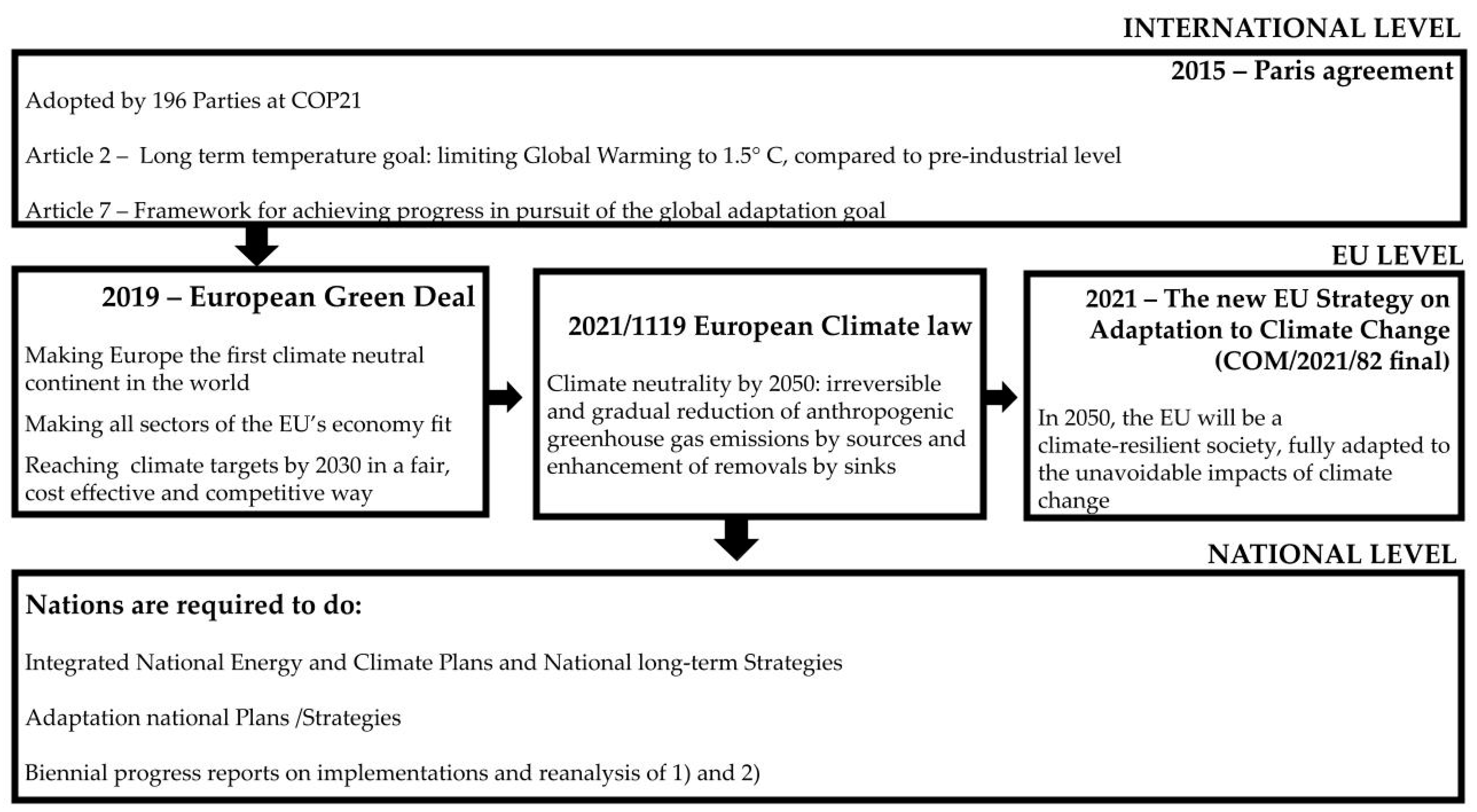
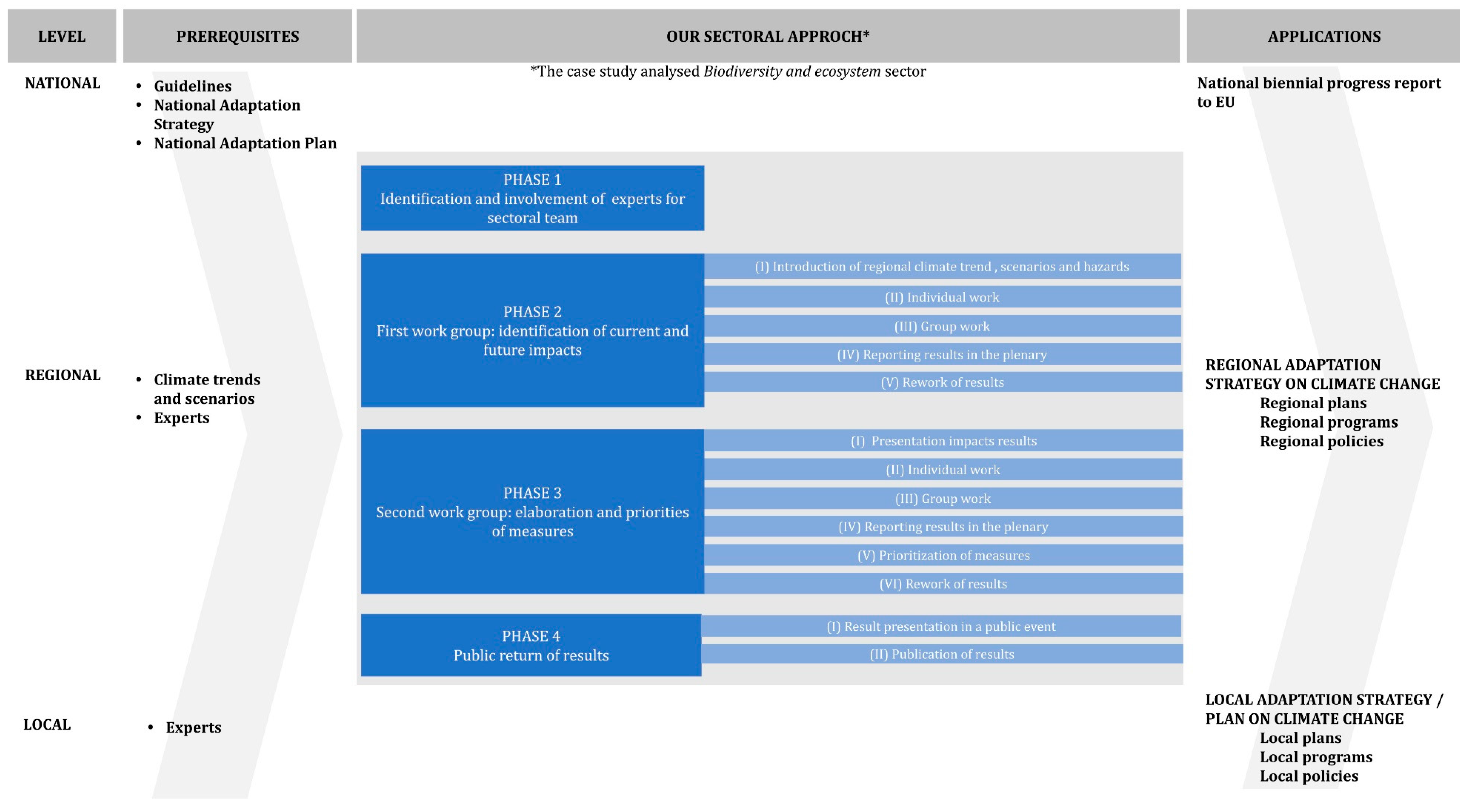
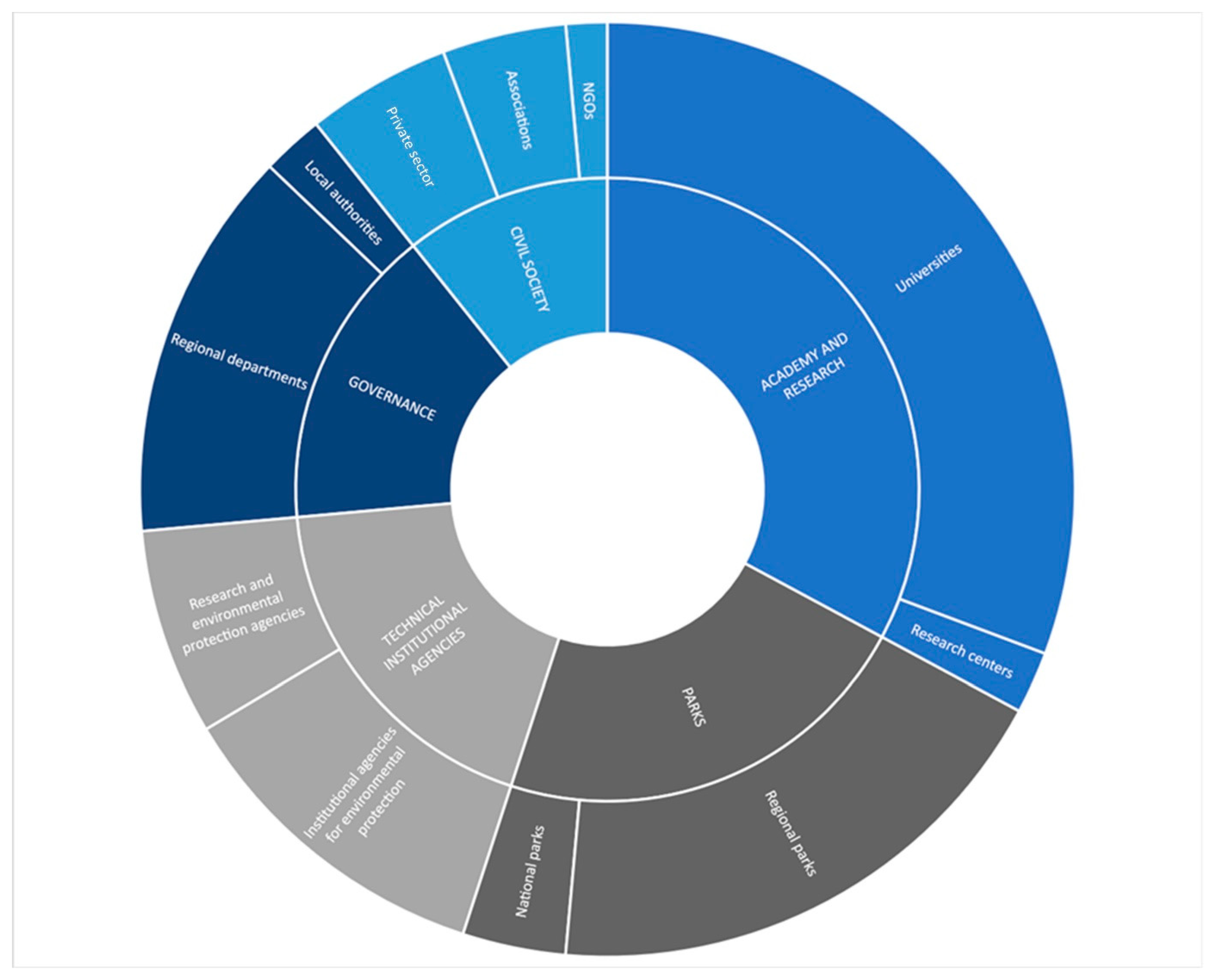
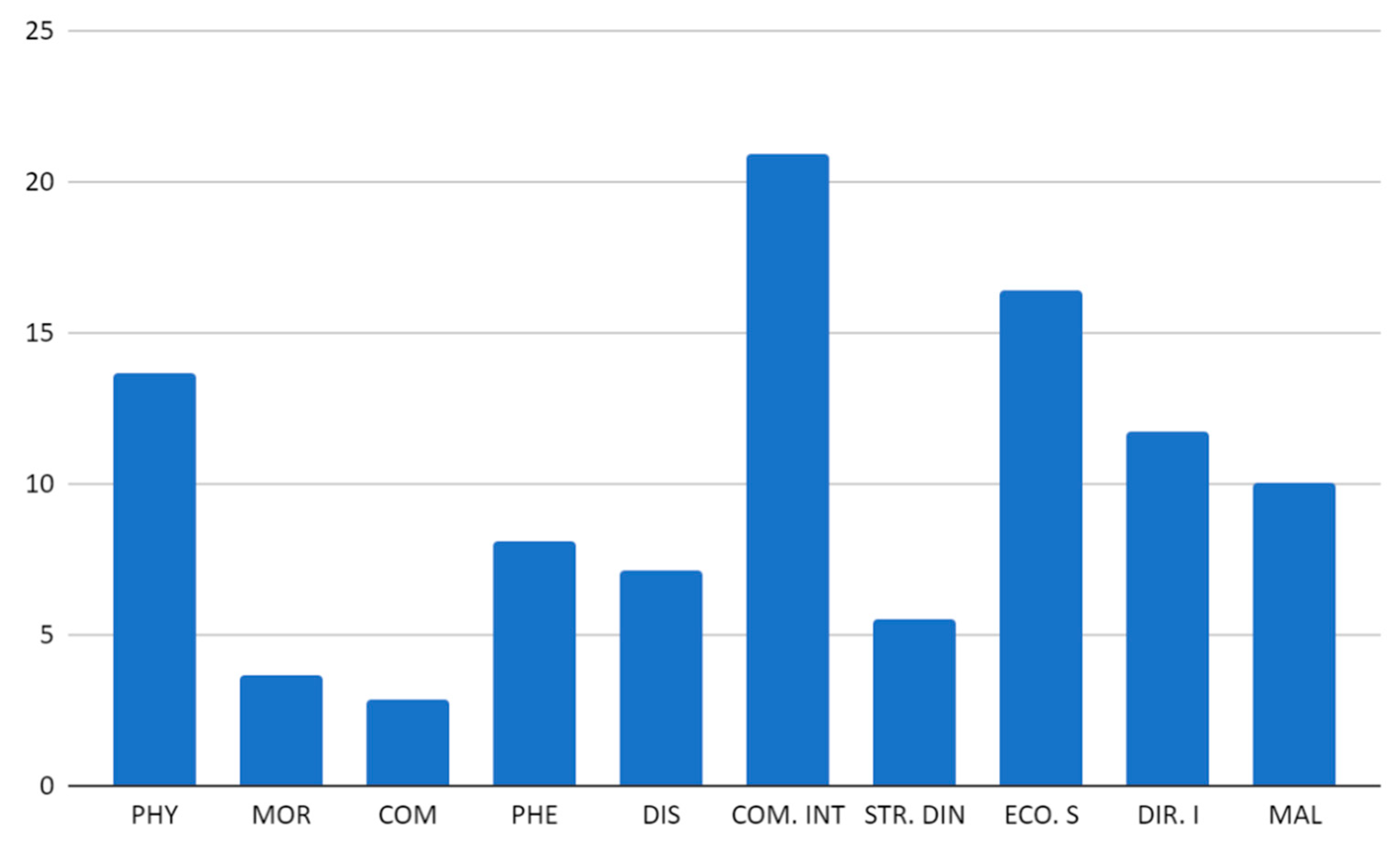
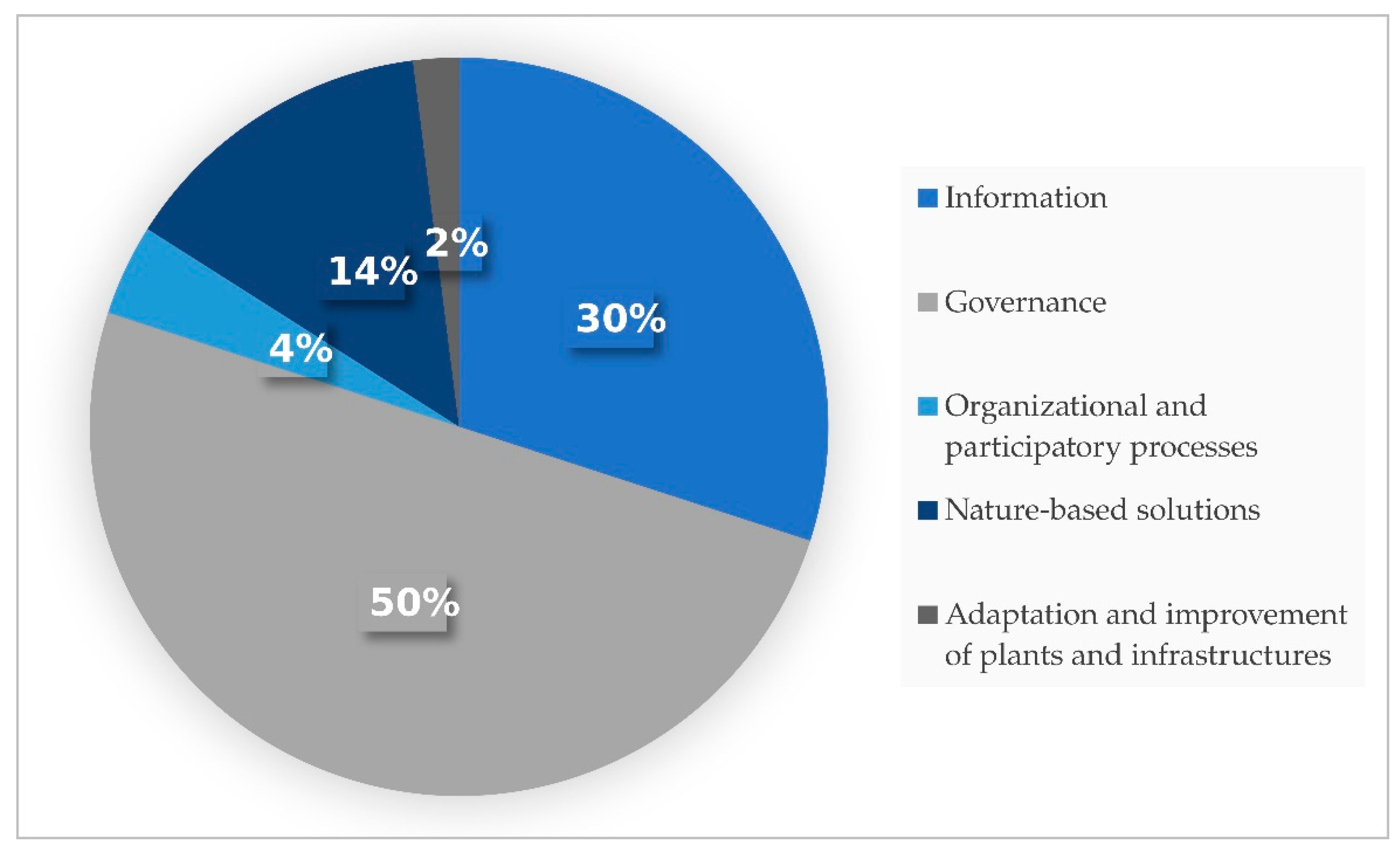
| Macro-Categories | Categories |
|---|---|
| Information | Research, evaluation, monitoring, data, models |
| Governance | Disclosure, perception, awareness, and education Adjustments of regulations, plans, programs, and strategies Economic and financial tools |
| Path | |
| Organizational and participatory processes | Partnership and participation |
| Institutions | |
| Organization and management | |
| Nature-based solutions | Integrated solutions |
| Forest, agro-forest, and river ecosystems | |
| Adaptation and improvement of technological plants and infrastructures | Machinery, materials, and technologies |
Publisher’s Note: MDPI stays neutral with regard to jurisdictional claims in published maps and institutional affiliations. |
© 2022 by the authors. Licensee MDPI, Basel, Switzerland. This article is an open access article distributed under the terms and conditions of the Creative Commons Attribution (CC BY) license (https://creativecommons.org/licenses/by/4.0/).
Share and Cite
Pollo, A.; Piccini, I.; Chiara, J.; Porro, E.; Chiantore, D.; Gili, F.; Alba, R.; Barbi, A.; Bogliani, G.; Bagliani, M.; et al. An Innovative Approach for Subnational Climate Adaptation of Biodiversity and Ecosystems: The Case Study of a Regional Strategy in Italy. Sustainability 2022, 14, 6115. https://doi.org/10.3390/su14106115
Pollo A, Piccini I, Chiara J, Porro E, Chiantore D, Gili F, Alba R, Barbi A, Bogliani G, Bagliani M, et al. An Innovative Approach for Subnational Climate Adaptation of Biodiversity and Ecosystems: The Case Study of a Regional Strategy in Italy. Sustainability. 2022; 14(10):6115. https://doi.org/10.3390/su14106115
Chicago/Turabian StylePollo, Alessandra, Irene Piccini, Jacopo Chiara, Elena Porro, Daniela Chiantore, Fabrizio Gili, Riccardo Alba, Andrea Barbi, Giuseppe Bogliani, Marco Bagliani, and et al. 2022. "An Innovative Approach for Subnational Climate Adaptation of Biodiversity and Ecosystems: The Case Study of a Regional Strategy in Italy" Sustainability 14, no. 10: 6115. https://doi.org/10.3390/su14106115
APA StylePollo, A., Piccini, I., Chiara, J., Porro, E., Chiantore, D., Gili, F., Alba, R., Barbi, A., Bogliani, G., Bagliani, M., Doretto, A., Ruffino, C., Malenotti, E., Garazzino, A., Pelosini, R., Siniscalco, C., & Bonelli, S. (2022). An Innovative Approach for Subnational Climate Adaptation of Biodiversity and Ecosystems: The Case Study of a Regional Strategy in Italy. Sustainability, 14(10), 6115. https://doi.org/10.3390/su14106115






